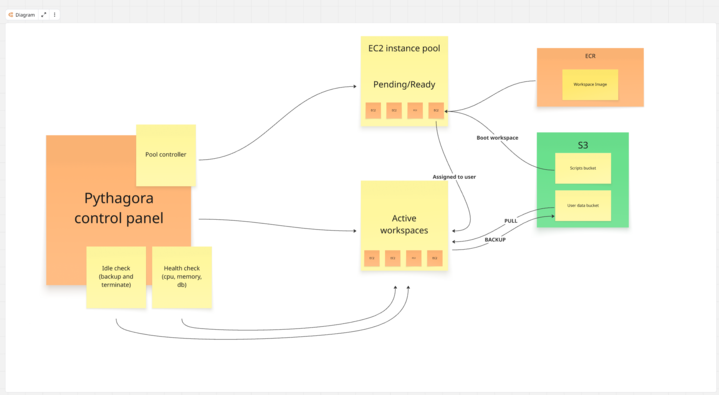Our $100K Cloud Problem Had a 2-Week Vibe Coding Solution

3 Cloud Experts Failed. Pythagora Solved It in 2 Weeks.
For five months, we struggled with our cloud architecture. Multiple engineers tried different approaches. Kubernetes configurations that took weeks to debug. Five separate repositories creating exponential complexity. Then our engineer did something that shouldn't be possible: he replaced our entire Kubernetes setup with a custom solution built using Pythagora in just two weeks.
Here's how we went from configuration hell to a system that actually works.
The Problem: When Industry Standards Don't Fit
Building cloud infrastructure for AI development platforms isn't like building a regular website. Every user needs their own dedicated environment where they can code, build, and deploy. It's complex, specialized work that requires real expertise.
So we did what any startup would do: we hired experts.
We started building this in December. The first engineer tried one technology stack, but it didn't work. The second DevOps engineer / expert in Kubernetes tried a different approach, but the architecture was wrong. In both of these approaches, we went with Kubernetes because that's what you're supposed to use for container orchestration at scale.
The Kubernetes reality:
- Five separate Git repositories
- Weeks spent configuring monitoring, logging, and management tools
- Three-day debugging sessions for issues we couldn't understand
- Complex system where every change broke something else
The "right" approach wasn't working. The experts were stuck. We were running out of budget and patience. Marco, our infra engineer, was spending all his time just keeping the system running. Probably at that time, we all realized we needed a different approach.
The Vibe Coding Experiment: What If We Just Built It?
"How can we make this more maintainable and reduce complexity?" became our desperate question.
Instead of hiring another expert or buying another enterprise solution, we decided to try something different: vibe coding our way to a solution.
Marco sat down with Pythagora and started describing what we actually needed:
- "When a user connects, assign them workspace and execute boot scripts"
- "Generate dashboard plane where I can execute remote commands and create alerting/monitoring service"
- "Implement locking mechanism to avoid race conditions in workspace assignments"
- "Create cronjob that scans filesystem usage, and terminates idle workspaces"
No configuration files. No pre-built tools. Just natural language descriptions of what we wanted the system to do.
Week 1: Designing in Plain English
Instead of studying Kubernetes documentation, Marco had conversations with Pythagora about architecture:
Marco: "We need to prevent race conditions when users connect to instances"
Pythagora: Generates code that handles instance assignment with proper locking
Marco: "Expose performance metrics for each active workspace, and scrape them with logging and alerting."
Pythagora: Creates cronjob together with statistics dashboard and alerting page
Every component was built specifically for our needs. No generic solutions forced to fit our use case.

Week 2: Implementation Without Configuration Hell
The second week was pure building. Pythagora generated the infrastructure code while Marco reviewed every line.
The key difference: Instead of configuring existing software to work for us, we built software that worked exactly how we wanted.
No Kubernetes YAML files. No hunting through documentation for the right configuration. Just code that did exactly what we described.
The Results: $100K Problem, 2-Week Solution
6 months with experts:
- Multiple failed attempts
- $100K+ in hiring costs
- 5 separate repositories
- System too complex for anyone to fully understand
- Still no working solution
2 weeks with vibe coding:
- Working cloud infrastructure
- Single maintainable codebase
- Bugs that could be fixed in hours, not days
- System built exactly for our needs
We believe the most surprising part was that the bug rate was lower than expected. When you build something from scratch and understand every component, debugging becomes manageable.
Why This Matters for AI Development
This isn't just a cool engineering story. Or about experts being bad at their jobs. It's about the wrong approach to the problem. It represents a fundamental shift in how we approach software problems.
Traditional approach: Find the industry-standard tool, spend months configuring it to fit your needs, hire specialists to maintain it.
AI-first approach: Describe what you want, build it specifically for your use case, maintain it with the person who understands it best.
Marco put it perfectly: "It's like the difference between buying a CRM and configuring it for your workflow versus building a CRM that fits your workflow from day one." The AI approach started with our actual requirements, not industry assumptions.
The Broader Lesson
We've been telling people that AI can help them build applications faster. But we just proved it (after 5 months of pain) can also help experienced engineers build infrastructure that replaces industry-standard solutions.
Key insights:
- Sometimes simple beats complex, even if it's more expensive
- Building exactly what you need often works better than configuring what exists
- AI allows small teams to build systems that previously required large DevOps teams
- Understanding your code matters more than using the "right" tools
The $100K Question
This experience changed how we think about software architecture. When you can build custom solutions quickly, you don't have to accept the complexity that comes with off-the-shelf tools.
We're not saying everyone should now replace Kubernetes. But we are saying that AI dev platforms enable approaches that weren't possible before.
About the $100K question:
- How many other "expert problems" are actually "wrong tool" problems?
- How many startups are burning cash on specialists to implement solutions that don't fit their actual needs?
- How many teams are maintaining complex systems because "that's how it's supposed to be done"?
Marco built our entire cloud infrastructure using Pythagora in two weeks. Just clear thinking about what we actually needed and AI that could build it.
The Bottom Line
2 weeks of vibe coding replaced 5 months of dealing with Kubernetes and the end result was 100% better. Simpler architecture, faster debugging, complete understanding of our own system, and infra that actually serves our needs instead of fighting against them.
Sometimes the best solution isn't the industry standard. Sometimes it's the one you build yourself.
The Pythagora Team
